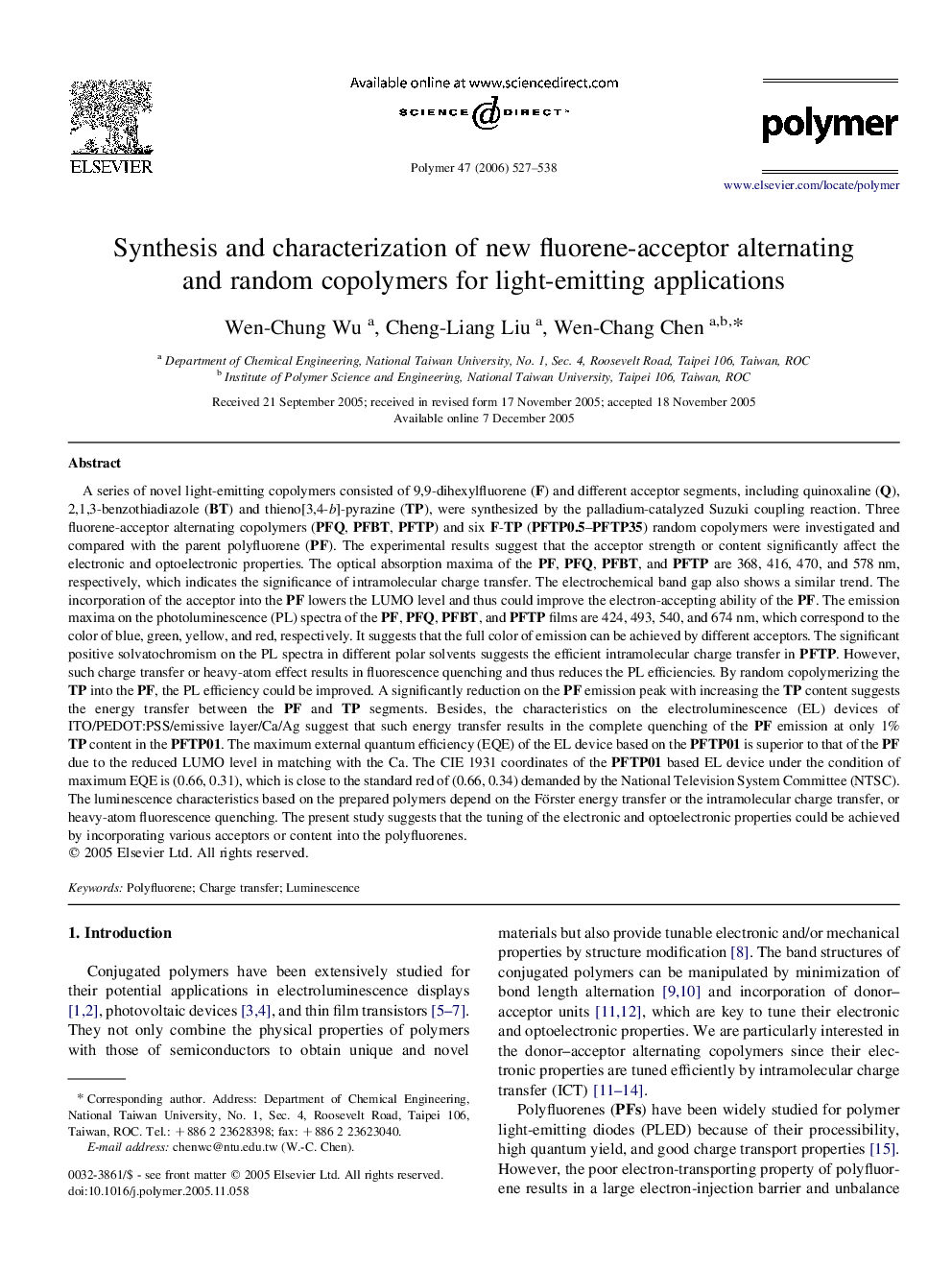| کد مقاله | کد نشریه | سال انتشار | مقاله انگلیسی | نسخه تمام متن |
|---|---|---|---|---|
| 5189402 | 1381184 | 2006 | 12 صفحه PDF | دانلود رایگان |
عنوان انگلیسی مقاله ISI
Synthesis and characterization of new fluorene-acceptor alternating and random copolymers for light-emitting applications
دانلود مقاله + سفارش ترجمه
دانلود مقاله ISI انگلیسی
رایگان برای ایرانیان
موضوعات مرتبط
مهندسی و علوم پایه
شیمی
شیمی آلی
پیش نمایش صفحه اول مقاله

چکیده انگلیسی
A series of novel light-emitting copolymers consisted of 9,9-dihexylfluorene (F) and different acceptor segments, including quinoxaline (Q), 2,1,3-benzothiadiazole (BT) and thieno[3,4-b]-pyrazine (TP), were synthesized by the palladium-catalyzed Suzuki coupling reaction. Three fluorene-acceptor alternating copolymers (PFQ, PFBT, PFTP) and six F-TP (PFTP0.5-PFTP35) random copolymers were investigated and compared with the parent polyfluorene (PF). The experimental results suggest that the acceptor strength or content significantly affect the electronic and optoelectronic properties. The optical absorption maxima of the PF, PFQ, PFBT, and PFTP are 368, 416, 470, and 578Â nm, respectively, which indicates the significance of intramolecular charge transfer. The electrochemical band gap also shows a similar trend. The incorporation of the acceptor into the PF lowers the LUMO level and thus could improve the electron-accepting ability of the PF. The emission maxima on the photoluminescence (PL) spectra of the PF, PFQ, PFBT, and PFTP films are 424, 493, 540, and 674Â nm, which correspond to the color of blue, green, yellow, and red, respectively. It suggests that the full color of emission can be achieved by different acceptors. The significant positive solvatochromism on the PL spectra in different polar solvents suggests the efficient intramolecular charge transfer in PFTP. However, such charge transfer or heavy-atom effect results in fluorescence quenching and thus reduces the PL efficiencies. By random copolymerizing the TP into the PF, the PL efficiency could be improved. A significantly reduction on the PF emission peak with increasing the TP content suggests the energy transfer between the PF and TP segments. Besides, the characteristics on the electroluminescence (EL) devices of ITO/PEDOT:PSS/emissive layer/Ca/Ag suggest that such energy transfer results in the complete quenching of the PF emission at only 1% TP content in the PFTP01. The maximum external quantum efficiency (EQE) of the EL device based on the PFTP01 is superior to that of the PF due to the reduced LUMO level in matching with the Ca. The CIE 1931 coordinates of the PFTP01 based EL device under the condition of maximum EQE is (0.66, 0.31), which is close to the standard red of (0.66, 0.34) demanded by the National Television System Committee (NTSC). The luminescence characteristics based on the prepared polymers depend on the Förster energy transfer or the intramolecular charge transfer, or heavy-atom fluorescence quenching. The present study suggests that the tuning of the electronic and optoelectronic properties could be achieved by incorporating various acceptors or content into the polyfluorenes.
ناشر
Database: Elsevier - ScienceDirect (ساینس دایرکت)
Journal: Polymer - Volume 47, Issue 2, 13 January 2006, Pages 527-538
Journal: Polymer - Volume 47, Issue 2, 13 January 2006, Pages 527-538
نویسندگان
Wen-Chung Wu, Cheng-Liang Liu, Wen-Chang Chen,